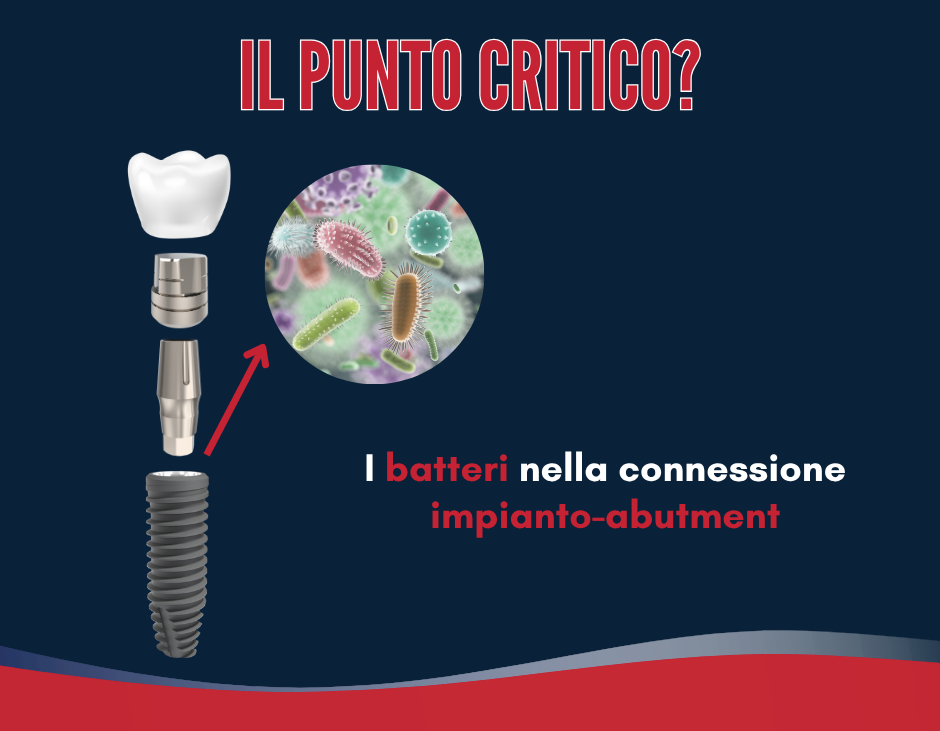According to recent studies published in PubMed, peri-implantitis affects at least 1 in 5 patients after prosthetic implant treatment. This data underlines the urgency of having a clear understanding of the risk factors that cause the onset of peri-implantitis, so that effective and concrete evidence-based preventive measures can be identified and put in place.
With almost forty years of experience in the implant sector, BioService has always been at the front line in the prevention of biological complications, offering its customers all the tools they need to minimise the occurrence of peri-implantitis.
But what is the critical point from which it all starts? To truly understand how to reduce the risk of peri-implantitis, it is essential to start at the root of the problem: the implant-abutment connection.
Summary
The bacterial origin of peri-implantitis: the implant-abutment connection
The main risk factor for peri-implantitis is the presence of bacteria. In early forms, these microorganisms penetrate through infiltration into the implant-abutment connection, rapidly spreading to the crestal bone zone. In other cases, bacterial contamination may develop later in time, fostered by poor oral hygiene, a bad lifestyle, unhealthy habits such as smoking or an unbalanced diet.


Not only this, but among the most frequent causes of early contamination are also cement residues from the procedure of fixing the prosthetic crown on the abutment or repeated disconnections of the abutment for clinical reasons (impression taking, insertion of the temporary and definitive). Such disconnections can damage the epithelial and connective tissue adjacent to the implant, creating a lesion that exposes the adjacent tissues to bacterial attack.

All these elements, if not properly managed, can compromise the health of peri-implant tissues, creating an environment favourable to the development of infections.

All these elements, if not properly managed, can compromise the health of peri-implant tissues, creating an environment favourable to the development of infections.
The BioService approach: integrated prevention, operational simplicity
With almost 40 years of experience and research in the field, BioService has developed a comprehensive range of effective solutions for each of these risk factors, backed by extensive scientific literature without sacrificing the simplicity typical of the company's operating protocols.
1.Morse taper implant connectionThe ConEx® (Morse taper) connection implant line reduces the bacterial load that could form in the connection area with the abutment due to a better closure between the contact surfaces.This results in less chance of inflammation and infection, reducing the possibility of bone resorption.
2.Platform Switching and transmucosal design
It is crucial to keep any bacterial load as far away as possible from the area where the implant is in contact with the bone tissue in the cortical area. This distance is called “biological width”.
To fully exploit these advantages, several implant types in the MaTrix® line feature a reduction in the connection diameter with the abutment compared to the total diameter of the implant (Platform Switching). This configuration allows the use of undersized prosthetic components, thus a reduction in horizontal volumes, minimising the risks of peri-implant disease by moving any bacterial infiltrate away from the bone tissue.
And what about vertical clearance? Here too, the MaTrix® implant line offers an adequate solution, with three types of issue Level implants.The essential characteristic of these implants lies in the transgingival portion, which moves the implant platform to the gingival level, thus away from the underlying bone tissue. Extensive literature supports this implant type, highlighting in many studies how the percentage of contracting peri-implantitis is drastically reduced in the presence of transmucosal designs.
3.Conical abutments
A further crucial aspect in the prevention of peri-implantitis concerns prosthetic components, in particular the wide range of conical abutments proposed by BioService. These devices address two specific risk factors:
As far as repeated disconnections are concerned, the problem is effectively eliminated once the abutment has been connected to the implant and all further abutments are then fixed directly onto it. Again, the scientific literature has demonstrated a positive impact on bone loss, showing a significant reduction.
1.Morse taper implant connectionThe ConEx® (Morse taper) connection implant line reduces the bacterial load that could form in the connection area with the abutment due to a better closure between the contact surfaces.This results in less chance of inflammation and infection, reducing the possibility of bone resorption.
2.Platform Switching and transmucosal design
It is crucial to keep any bacterial load as far away as possible from the area where the implant is in contact with the bone tissue in the cortical area. This distance is called “biological width”.
To fully exploit these advantages, several implant types in the MaTrix® line feature a reduction in the connection diameter with the abutment compared to the total diameter of the implant (Platform Switching). This configuration allows the use of undersized prosthetic components, thus a reduction in horizontal volumes, minimising the risks of peri-implant disease by moving any bacterial infiltrate away from the bone tissue.
And what about vertical clearance? Here too, the MaTrix® implant line offers an adequate solution, with three types of issue Level implants.The essential characteristic of these implants lies in the transgingival portion, which moves the implant platform to the gingival level, thus away from the underlying bone tissue. Extensive literature supports this implant type, highlighting in many studies how the percentage of contracting peri-implantitis is drastically reduced in the presence of transmucosal designs.
3.Conical abutments
A further crucial aspect in the prevention of peri-implantitis concerns prosthetic components, in particular the wide range of conical abutments proposed by BioService. These devices address two specific risk factors:
- lthe vertical distance tbetween the implant platform and the bone tissue, analysed in the previous point;
- the repeated disconnection of abutments in intermediate clinical phases.
As far as repeated disconnections are concerned, the problem is effectively eliminated once the abutment has been connected to the implant and all further abutments are then fixed directly onto it. Again, the scientific literature has demonstrated a positive impact on bone loss, showing a significant reduction.
Conclusion
The implant-abutment connection is a strategic clinical choice in the prevention of implant complications. Choosing the correct implant-abutment connection means drastically reducing bacterial exposure, protecting tissues and guaranteeing treatment durability.
Thanks to technical expertise and continuous scientific updating, BioService offers dental professionals safe, high-performance, repeatable and scientifically validated solutions to effectively combat peri-implantitis.
Thanks to technical expertise and continuous scientific updating, BioService offers dental professionals safe, high-performance, repeatable and scientifically validated solutions to effectively combat peri-implantitis.

